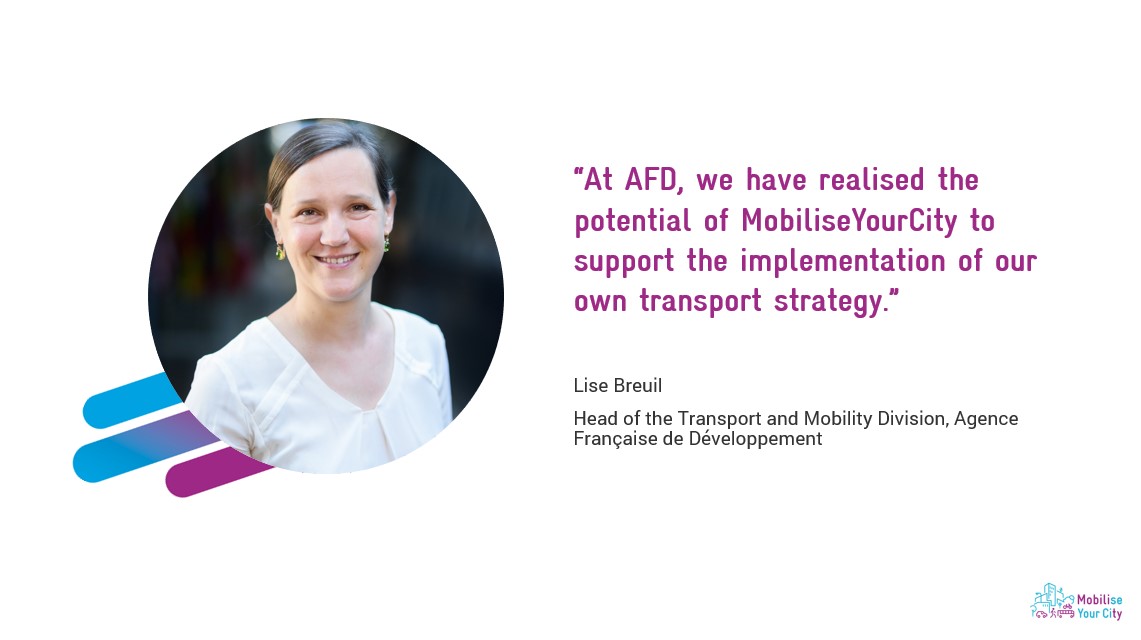The Agence Française de Développement becomes the new Chair of MobiliseYourCity

Lise Breuil, Head of the Transport and Mobility Division at the Agence Française de Développement (AFD) shares the perspective of AFD on their engagement with the Partnership as the Agency takes on the role of chair of the Steering Committee for the next two years.
Question 1: What is AFD’s strategy for the urban transport sector?
Urban mobility represents 60% of our average annual commitments, ie more than 500 million euros /year.
The first priority for us is to accompany as soon as possible the policy dialogue in a country or a city, to be able to co-design a project with our client and partner. In that regard, the MobiliseYourCity Partnership is a critical tool for us, as it ensures better planning and therefore better projects.
Secondly, we try to enhance as much as possible the positive impacts of the projects. The request of our clients and partners is generally focused on mass transit. By “enhancing positive impacts”, we mean, for example:
- Improving urban integration through ad hoc studies around stations, with a focus on accessibility by foot and by bike
- Being able to better assess the impacts on climate change, in terms of reduction of GHG emissions
- Improving multimodal integration through multimodal hubs and ticketing
- Fostering a gender perspective in the construction and operation
- Focusing on ‘pro-poor’ approaches to improve affordability
- Supporting governance in the transport sector, etc.
This means, generally speaking, pushing forward priority topics such as digital, paratransit, active modes, climate adaptation, governance, affordability as well as transverse issues such as air quality.
Thirdly, we would like to place secondary cities, which are often neglected, higher on the agenda. These cities require a proper approach to sustainable mobility. We are keen on developing such approaches with a focus on improving active modes and road safety, as well as modernising the bus sector, whether formal or informal.
Question 2: Looking back at those five years, what results are you most proud of?
After five years as a key implementing partner and three years as a donor of the MobiliseYourCity Partnership, we are proud to have contributed to creating a knowledge hub to promote low carbon urban mobility. The Partnership offers multiple tools and methodologies, which build on the diverse strengths of the partners, for planning in a participative way and measuring impacts. These methodologies and tools help set up high standards for SUMPS and NUMPs.
The results of the first five years confirm our belief that Sustainable Urban Mobility Plans (SUMPs) are an efficient instrument to leverage finance for sustainable mobility projects. Ultimately this will help shape green and smart cities.
More recently, we have encouraged the Partnership to address complex but critical topics such as paratransit to better support our member cities and countries. We are glad to see the enthusiasm triggered by the first publications on this topic and see concrete actions emerging as a result.
Question 3: What are AFD’s priorities for the Partnership in the next two years? What is the vision of AFD for the Partnership’s long-term future?
In our time as chair, we want first to make sure that the new service area of the Partnership – Implementation support – which was added in the strategy adopted in December 2020, is really implemented. This means leveraging additional finance to develop ad hoc projects on paratransit modernisation, support to active modes, support to governance, and developing methodologies and best practices.
In addition, we hope to continue pushing for additional support for other priority topics that emerge from mobility planning projects. These include governance, climate adaptation, affordability.
At AFD, we have realised the potential of MobiliseYourCity to support the implementation of our own transport strategy. In the long term, we hope other partners can leverage the Partnership as much as we have been able to.